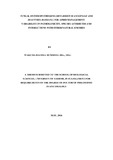| dc.description.abstract | ABSTRACTAphids are regarded as one of the most important pest problems of vegetable crops worldwide. Most vegetable growers in sub-Saharan Africa heavily rely on chemical insecticides for control of aphids. However, the synthetic insecticided have detrimental effects on users, consumers and the environment. Fungal-based biopesticides are being considered as alternatives to synthetic chemical insecticides. This study evaluated the virulence of five isolates of Metarhizium anisopliae (Metsch.) Sorok. and three of Beauveria bassiana (Bals.) Vuill. against apterous adults of Brevicoryne brassicae (L.), Lipaphis pseudobrassicae (Davis) and Aphis gossypii (Glover). The thermotolerance and conidial yield of the isolates were also evaluated as a prerequisite for strain selection. Three isolates of M. anisopliae ICIPE 30, ICIPE 62 and ICIPE 69 outperformed the other fungal isolates, causing mortality of 85-98%, 83-97%, and 73-77%, in B. brassicae, L. pseudobrassicae and A. gossypii, respectively, 7 d post-inoculation. Isolate ICIPE62 had the shortest LT50 values of 2.2, 1.6 and 1.5 d; and the lowest LC50 values of 0.3 105, 0.1 105 and 0.05 105 conidia ml-1 against A. gossypii, B. brassicae and L. pseudobrassicae, respectively. Furthermore, ICIPE 62 produced more conidia on the surface of aphid cadavers than ICIPE 30 and ICIPE 69 and showed wider thermotolerance with optimum ranges of 25-30ºC. Compared to other isolates, ICIPE 62 appeared to have a broad temperature range of in vitro germination, growth and pathogenic activity against the target pests. Isolate ICIPE 62 was, therefore, chosen for further interaction with other natural enemies of aphids and screenhouse and/or field studies.
Laboratory studies were carried out to investigate interaction between three vegetable-infesting aphids, candidate isolate ICIPE 62 and predatory beetle Cheilomenes lunata (Fabricius). At a concentration of 1 108 conidial ml-1, the fungus was found to cause mortality of 7.5% to C. lunata compared to 2.5% mortality in the control 10 days post-treatment. Female adult C. lunata to which fungus-infected aphids were offered as prey did not accept them as food source in non-choice bioassays. However, both starved and non starved C. lunata fed on live and dead non-infected aphids. In choice bioassay, a total of 1-3 out of 24 infected non-sporulating aphids (average of 0.1-0.4 aphids per arena) were consumed by 48 h starved C. lunata within a period of 60 min, but avoided sporulating cadavers. Foraging adult C. lunata enhanced the spread of conidia from infected cadavers to healthy aphids, A. gossypii feeding on okra (0.8-15.0% mortality),
B. brassicae (3.3-15.0% mortality) and L. pseudobrassicae (0.8-14.2% mortality) on kale plants. Results of this study demonstrate compatibility between M. anisopliae isolate ICIPE 62 and C. lunata, and could provide a sustainable strategy for effective management of aphids on crucifers and okra cropping systems.
The study further investigated the interaction between isolate ICIPE 62 and two important aphid parasitoids: Aphidius colemani and Diaeretiella rapae under laboratory conditions to determine if use of the fungus against the aphid hosts had effect on parasitism, emergence, sex ratio, morphomety and longevity of F1 generation of the parasitoids. The results showed normal development of A. colemani (upto 54-91% adult emergence) when its host A. gossypii was first exposed to the parasitoid and then treated with fungus, and 38-92% when it was treated with fungus and then exposed to the parasitoid after 24, 48 or 72 h. A similar trend was also observed for D. rapae (i.e. 53-83% and 43-89% adult emergence) when its host aphids B. brassicae was treated with fungus before and after parasitism. Conidial concentration and time of exposure had no significant effect on emergence, developmental time, sex ratio, tibial length, wing length and longevity of F1 generation of A. colemani and D. rapae. This suggests that both parasitoid species and M. anisopliae ICIPE 62 may be used together for the integrated management of aphids as long as fungus applications do not interfere with development of the parasitoids.
The potential of candidate isolate ICIPE 62 was further investigated under screenhouse and field condition. The screenhouse experiment was conducted to determine appropriate conidial formulation as a prerequite for field efficacy test. The results showed that application of conidia of ICIPE 62 formulated in aqueous and oil had negative effect on aphid population growth rate (ri) on kale and okra compared to the controls in screenhouse experiments. However, conidia formulated in oil was found to be superior over aqueous formulation, causing mortality upto 93.8% and 95% in A. gossypii and B. brassicae, respectively. Based on these results, oil formulation was chosen and further evaluated under field contions. The efficacy of two conidial concentrations formulated in oil were evaluated under field conditions. Chemical insecticide (Karate®) and water were used as controls. Metarhizium anisopliae was
applied at the rate of 110¹² conidia ha-1 and 51012 conidia ha-1, and Karate® was applied at the recommended rate of 17.5 g a.i ha-1.
Weekly applications of the fungus and Karate® were compared for two seasons. In all the trials, aphids density was significantly lower in the fungal and chemical insecticide treated okra and kale plots compared to the control. However, no significant variation was observed in aphids density between Karate® treated and control during the second season. The reduction in the aphids density resulted in yield increament in both crops except that no significant difference was observed for okra during the second cropping season. Moreover, higher proportion of aphids mortality with mycosis was observed in fungal treated plots and few in control plots. These findings have demonstrated the potential of M. anisopliae isolate ICIPE 62 in suppression of the three aphid species populations, broad termotolerance ability and compatibility with other natural enemies of aphids. The ICIPE 62 can be used as biopesticide and/or IPM package for the control of A. gossypii, B. brassicae and L. pseudobrassicae in okra and crucifer cropping systems and, reduce reliance on synthetic chemical insecticides and their associated risks. | en_US |



